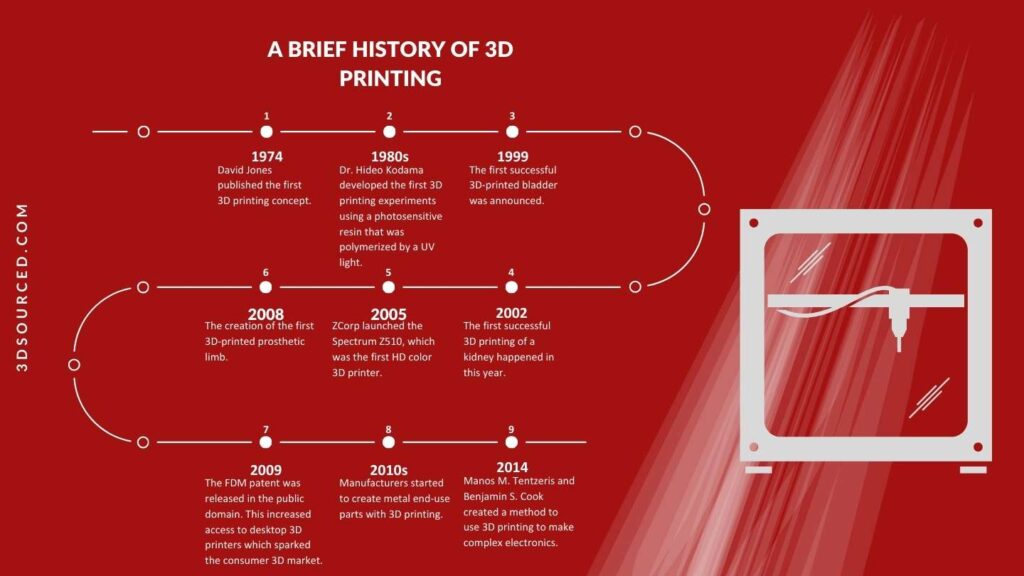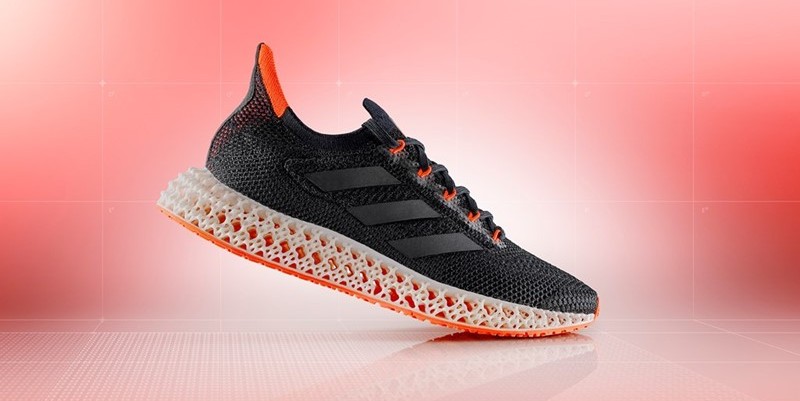Key 3D Printing Stats

- In 1984, Bill Masters patented the first 3D printer.
- 3D printing is one of the most disruptive technologies and is estimated to lead the 4th industrial revolution. [4]
- The global 3D printing market size was valued at USD 16.75 billion in 2022 and is projected to grow at a compound annual growth rate (CAGR) of 23.3% from 2023 to 2030. [6]
- Modern 3D printers cost between $200 and $10,000 depending on the quality and requirements. [8]
Stats About the History of 3D Printing

For its relatively short history, 3D printing has garnered some impressive feats. It seemed almost immediately in its young life it began revolutionizing the medical field, with prosthetics and organ transplants receiving the brunt of the attention.
But it wasn’t until 2009 that it started transforming into the consumer product we see today.
- In 1974, David Jones published the first 3D printing concept. [7]
- Dr. Hideo Kodama developed the first 3D printing experiments in the 1980s. It used a photosensitive resin that was polymerized by a UV light. [1]
- The first bladder was successfully printed in 1999.
- The first kidney was printed in 2022.
- ZCorp launched the Spectrum Z510 in 2005, which was the first high-definition color 3D printer. [1]
- The first 3D-printed prosthetic limb was created in 2008. [1]
- The FDM patent landed in the public domain in 2009, leading to an innovative wave of 3D printers and increased access to desktop 3D printers. This sparked the consumer 3D market. [1]
- In the 2010s, manufacturers started to create metal end-use parts with 3D printing. [7]
- In 2014, Manos M. Tentzeris and Benjamin S. Cook created a method to use 3D printing to make complex electronics. [7]
3D Printing Use Cases & Users

Who is using 3D printing and how are they using it? Companies (and now everyday people) for endless reasons. Let’s break it down.
- Desktop 3D printers are increasingly used for domestic and household purposes [6]
- Healthcare’s 3D printing market size was valued at $1,036.58 million in 2020 and is predicted to reach $5,846.74 million by 2030 at a registered CAGR of 20.10%. [13]
- Schools, universities, and educational institutes are also leveraging desktop 3D printers for training and research.
- The 3D-printed prosthetics, orthotics, and audiology market will gain $509 million in revenue by 2026 and grow to $996 million by 2030. [14]
- Adidas has developed 3D-printed midsoles for its new 4DFWD shoes. [12]

- Small businesses are beginning to offer 3D printing services to meet customer needs.
- Prototyping was the most common 3D printing application in 2022, accounting for over 54% of global revenue. [6]
- Accounting for 23% of global revenue share in 2022, the automotive segment led the market in 2022.
- With over 33% of revenue share, North America led the market in 2022.
Hardware Industry Facts & Stats
Hardware is the biggest sector of the 3D printing market. It includes applications (prototyping and functional parts), vertices (specific industries), and materials used for printing. Here’s what you need to know:
Compared to other industries – like the drone industry– 3D printing boasts relatively high CAGR percentages and has expected revenue operating in the billions over the next few years.
- Prototyping is the top hardware application market segment, capturing over 55% of revenue worldwide in 2020.
- The functional parts segment of the application market is expected to grow at a CAGR of 21.5% from 2021 to 2028, along with an increased demand for designing and building functional parts. [6]
- The automotive vertical holds the largest share of the industrial 3D printing market accounting for over 23% of the segment’s global revenue. [6]
3D Printing Cost & ROI

Let’s face it, a 3D printer and materials are going to cost a bit more than your standard inkjet and paper. But you may be surprised by how much money this technology can save companies as well.
- Entry-level printers for beginners can cost between $400 and $1000. [8]
- $10,000 is the standard cost for an industrial printer. [8]
- By using 3D printing for titanium parts, Boeing saved $3 million. [7]
- General Electric predicts they will save up to $5 million over the next decade by changing to 3D printing for manufacturing. [7]
- In less than 4 months, The Center for Advanced Design achieved an ROI on a Stratasys F370 3D printer. [9]
3D Printing Materials

Early 3D printers used only plastics, but now they can use many different materials, expanding their capabilities.
- In 2022, metal was the largest material segment for 3D printing, accounting for 52% of global revenue. [6]
- The fastest-growing materials in 3D printing are metals and metal alloys. This segment is expected to grow by over 28.2% between now and 2030. [6]
- Polymer had the second-largest share of revenue in 2022. [6]
- Ceramic is a newer material segment, but it’s expected to grow rapidly at a high CAGR of over 25% over the forecast period. [6]
- Discrete manufacturing is the top industry for 3D printing. [3]
Technology and Software

Moving forward, streamlining user-friendliness and ready-made part designs will be paramount to the growth of 3D printing software.
- Stereolithography (one of the oldest printing techniques) was the largest segment in the market, capturing over 10% of global revenue in 2022. [6]
- The design software segment accounted for 36.7% of global revenue, making it the largest software segment. [6]
- Scanning software demand is predicted to grow due to a demand to store scanned images of objects to use when needed.
- Between 2023 and 2030, scanning software is expected to have the highest CAGR of 24%. [6]
- Hardware is predicted to continue holding the largest revenue share, but software is expected to have the fastest CAGR over the next several years. [6]
- The market for on-demand parts services and CAD software is expected to triple by 2026. [4]
3D Printing Devices

Who’s making 3D printers? HP and GE have the most additive printing patents, but here’s what you need to know:
- By 2030, there are expected to be 2.8 million additive manufacturing and 3D printing devices worldwide.
- In 2022, GE had the most 3D printing patents in the United States. [5]
- The top 5 leading 3D printing companies are AutoDesk, HP Inc., 3D Systems, Desktop Metal, and Proto Labs.
- The world’s largest 3D printer manufacturer is AutoDesk, with a market capitalization of $68.22 billion. [10]
- After going public in December 2020, Desktop Metal’s market capitalization exceeded $7.5 billion in 2021, and received $575 million as part of a merger with special acquisitions company Trine Acquisition Corp.
3D Market Size & Growth

3D printing has already made its mark, and the future looks bright. Here’s a breakdown of the market:
- Between 2018 and 2026, the market for 3D printing materials is expected to grow by 12 percent annually to reach just under four billion U.S. dollars by 2026. [3]
- The 3D printing market is expected to grow by nearly 24% between 2020 and 2026. [4]
- By 2026, the global 3D printing market is expected to reach $37.2 billion dollars. [4]
- Hardware (including applications, materials, and vertices) is the leads global 3D printing market share. [6]
- In 2022, the industrial printer segment led the market, accounting for over 76% of global revenue because of the adoption of industrial 3D printers in the electronics, healthcare, automotive, and aerospace industries. [6]
Market Outlook for 3D Printing

According to Forbes, the future of 3D printing lies heavily in prototyping for both desktop and industrial printers.
It seems 3D printers are on the last stretch of the home run as the industry works towards developing this technology to satisfy diverse needs.
- Over the next decade, we expect the majority of manufacturing spending to shift to functional end-use parts as the technology becomes more affordable and widely adopted. [15]
- We expect to see additive manufacturing playing a bigger role in sustainability and conservation efforts as 3D printing has proven to reduce waste and energy consumption. [16]
- 3D printing will adopt the use of more specialized materials to meet the criteria in specialized fields. [16]
- The next frontier of 3D printing will be to move from small models and fixtures to functional end-use parts in mass production. [6]
Since the beginning, additive manufacturing has pushed the limits on creativity and production, and now it promises to do the same on a larger scale.
For 3D printing to achieve the monumental tasks ahead, speed and design capabilities need to be at the forefront of manufacturers’ goals to accommodate the growing need for this technology.
Sources:
[1] https://www.sculpteo.com/en/3d-learning-hub/basics-of-3d-printing/the-history-of-3d-printing/
[2] https://cloudtweaks.com/2015/03/3d-printing-history-organs/
[3] https://www.statista.com/statistics/590113/worldwide-market-for-3d-printing/
[4] https://www.statista.com/topics/1969/additive-manufacturing-and-3d-printing/#topicOverview
[5] https://www.statista.com/statistics/315386/global-market-for-3d-printers/
[6] https://www.grandviewresearch.com/industry-analysis/3d-printing-industry-analysis
[7] https://facts.net/3d-printing-facts/
[8] https://www.3dsourced.com/3d-printers/how-much-does-a-3d-printer-cost-price/#h-3d-printer-price-guide
[10] https://investingnews.com/daily/tech-investing/emerging-tech-investing/top-3d-printing-companies/
[11] https://wohlersassociates.com/press-releases/new-wohlers-report-2021-finds-7-5-growth-in-additive/
[13] https://www.alliedmarketresearch.com/3d-printing-healthcare-market
[15] https://www.designnews.com/automation/predictions-future-3d-printing
[16] https://www.jabil.com/blog/future-of-3d-printing-additive-manufacturing-looks-bright.html
“Our printers don’t just print objects, they print ‘oops’, ‘ah-ha’, and ‘not again’ moments.”





0 Comments